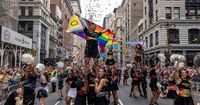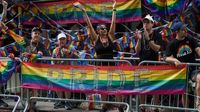On Sunday, June 29, 2025, New York City will once again become the vibrant epicenter of LGBTQ+ pride and protest as the annual New York City Pride March steps off in Manhattan. Expected to draw over a million attendees, this event stands as the largest Pride celebration in North America, featuring 60 floats and more than 75,000 marchers who will traverse a 1.8-mile route steeped in history and activism.
The parade’s theme this year, "Rise Up: Pride in Protest," pays homage to the 1969 Stonewall Uprising, a pivotal moment widely credited with sparking the modern LGBTQ+ rights movement. As Heritage of Pride organizers explain, the theme reflects the community’s origins in protest and serves as a powerful call to action amid rising hostility and legislative attacks against LGBTQ+ individuals nationwide.
Police Commissioner Jessica Tisch articulated the parade’s significance, emphasizing that "this parade is more than just a celebration of our LGBTQ+ community; it is a symbol of our acceptance, it's a symbol of how our diversity in this city will always be protected." She added, "We will not allow any form of hate to get in the way of that celebration." However, the event is unfolding against a backdrop of intensified political challenges and social pushback, making the march as much a statement of resilience as a celebration.
The march route begins on Fifth Avenue between 26th and Eighth Streets, then moves west on Eighth Street to Greenwich Avenue. It continues north briefly before heading west on Christopher Street, passing the Stonewall National Monument—a symbolic landmark honoring the 1969 riots. The procession then turns north on Seventh Avenue, passing the New York City AIDS Memorial, and concludes near 15th Street in Chelsea. Spectators can view the parade along this path, with the Grandstand situated at the General William Jenkins Worth Monument adjacent to Madison Square Park.
Alongside the march, PrideFest, the event’s annual street fair, will kick off at 11 a.m., running until 6 p.m. Food vendors, entertainment, and activities will enliven Fourth Avenue from 14th Street to Astor Place, offering a festive atmosphere for attendees. The parade itself is slated to begin at noon, with weather forecasts predicting possible morning showers but a pleasant afternoon with highs in the 80s.
Security measures have been significantly ramped up to ensure the safety of participants and spectators. The 1.8-mile route will be secured by 10,000 metal barriers, sanitation trucks, NYPD vehicles, and personnel from various specialized units, including emergency services, mounted units, K-9 teams, harbor patrol, and counterterrorism squads. Additionally, helicopters and drones will monitor the event from above, reflecting heightened vigilance despite no specific threats.
Street closures will impact much of the parade route and surrounding areas starting as early as 7 a.m. and intensifying by 10 a.m. The NYPD strongly urges attendees to use public transportation due to these closures and limited parking availability. Pedestrian crossings will be restricted to designated locations to maintain order and security.
While the parade is a time of joyous celebration, it also serves as a poignant reminder of the ongoing struggles facing the LGBTQ+ community, particularly transgender individuals. As Stacy Lentz, owner of the Stonewall Inn and CEO of an affiliated nonprofit, noted, "LGBTQ+ people and their supporters need to get back to the roots of Pride and what happened at Stonewall because our rights are under attack in a way we haven’t been in decades." She shared that young people often ask her what it was like to fight for rights back then, and she tells them, "We’ve never been closer to that time than we are right now. We all need to pick up the torch."
This sense of urgency is underscored by recent political developments. Since the legalization of same-sex marriage nationwide nearly a decade ago, backlash has grown, especially targeting transgender rights. David K. Johnson, a history professor at the University of South Florida, observed that while the gay and lesbian movement has surpassed early expectations, "trans people are the most vulnerable members of the LGBTQ community," and sometimes the broad term LGBTQ obscures more than it clarifies.
Public opinion polls echo this troubling trend. The Pew Research Center reports increased support for laws restricting transgender rights, such as banning gender-affirming care for minors and requiring sports participation based on birth sex. A Gallup poll from May 2025 found that 54% of Americans consider changing one’s gender morally wrong, up from 51% four years prior. Even the percentage of those viewing homosexuality as morally wrong rose sharply from 25% in 2022 to 33% in 2025. Sean Ebony Coleman, founder of the Bronx-based LGBTQ center Destination Tomorrow, lamented, "As my grandma used to say, ‘Now we are hustling backward.’"
The Trump administration's policies have particularly impacted transgender individuals and their allies. Post-inauguration executive orders dismantled diversity, equity, and inclusion (DEI) programs and restricted transgender rights, including barring openly transgender individuals from military service and prohibiting federal funds for what was termed "gender ideology." These moves led many corporations to cut donations to Pride events and severely harmed LGBTQ organizations reliant on federal grants for social services and research. Approximately $800 million in grants related to LGBTQ topics were canceled, disproportionately affecting health research for a community constituting roughly 10% of the U.S. population.
Symbolic setbacks have also occurred. Earlier this year, the National Park Service removed references to transgender people from the Stonewall National Monument’s web pages. Just last week, the U.S. Navy renamed a ship that had honored Harvey Milk, a pioneering openly gay elected official assassinated in 1978.
Recent Supreme Court rulings have further dashed hopes, upholding bans on transgender military service, parental rights to withdraw children from LGBTQ-themed school discussions, and restrictions on gender-affirming care for youth. The court also sided with a heterosexual woman who claimed discrimination by gay co-workers, underscoring the complex and sometimes contentious legal landscape.
The parade has also spotlighted internal tensions within the LGBTQ community. Police Commissioner Tisch criticized the event organizers for excluding the Gay Officers Action League from full participation because the group refused to march without their firearms, integral to their dress uniforms. In a letter shared with The New York Times on June 28, Tisch called this "the height of hypocrisy," noting the irony of requesting police protection while barring officers who represent the community. Police and corrections officers have been excluded from marching as a group since 2021 amid ongoing debates about law enforcement's role in Pride events. Tisch and members of the excluded group plan to protest their exclusion near the parade route at 11 a.m. on the day of the march.
Despite these challenges, the New York City Pride March remains a powerful symbol of resilience, community, and the ongoing fight for equality. As millions gather to march, cheer, and remember, the event embodies both a celebration of progress made and a defiant stand against the threats that persist. The streets of Manhattan will once again echo with the spirit of Stonewall—pride, protest, and the unyielding demand for dignity and rights.



